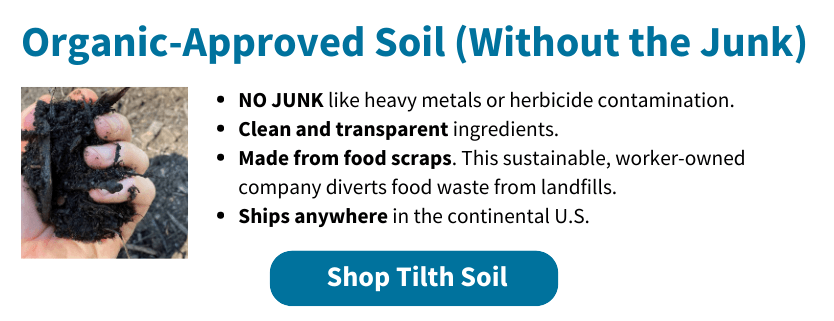Does Cow Manure & Shredded Leaves In The Garden Increase Acidity?


Heavy clay soil can frustrate even the most optimistic gardener. Follow this 6-step plan to improve soil structure and drainage so you can garden with ease and grow crops that thrive.
This page may contain affiliate links. Please read my disclosure for more info.

The compacted, hardpan dirt in my first yard was a despicable pass for soil.
The builders scraped off the topsoil when they built the home in 1955, and after the clay subsoil was nice and compacted by construction machinery, they placed sod right on top of it.
During a rain, water hit the hardpan clay soil like pavement and quickly sheeted away, unable to soak in and irrigate the lawn or hydrate the soil organisms below.
In the backyard, previous homeowners filled in the swimming pool with low-quality, heavy clay construction fill. Not only did I find blue-painted chunks of concrete when I tried to dig, the thought of trying to put a shovel into the clay sent shivers down my spine!
I wasn't sure how to create a healthy, productive garden without back-breaking labor to improve my situation. It seemed hopeless.
I added organic matter in large amounts, but the clay soil just seemed to swallow it up without showing any signs of improvement.
I figured there had to be a better way, so I started researching how to transform my hardpan dirt into rich, loamy-clay soil the way nature might do it. My research led me to a combination of steps that totally worked, and I'm excited to share them.
They'll have you feeling optimistic about your garden again! But first, let's look at what's good and not so good about clay soil.
The Good and the Bad of Clay Soil
Of all the different soil types (sand, clay, silt), clay soil is made up of the smallest and densest particles. These small and dense particles can cause drainage problems and become compacted easily. However, clay can also hold onto nutrients.
So, all is not lost, we just need to manage it properly!
Let's look at how to transform that solid, waterlogged soil into a rich, loamy clay that is just right for planting.

Correcting Clay Soil Problems
Following are a number of things you can do to make your clay soil amazing. The more of these steps you can take, the more amazing your soil — and garden crops — will be.
1: Contour the Land
Add contours to your garden terrain by creating a gentle undulation of alternating high peaks and low valleys. Contours of raised planting berms, terraces, raised beds, or even permaculture swales help slow and manage water.
As water undulates and slowly filters through high and low points on the land, it is oxygenated, which reduces waterlogging. Organic matter naturally builds up in low spots where water collects, while high spots provide planting areas that dry out faster.
If you plan to build raised beds, follow steps two and three below before constructing the beds so that you have a well-drained foundation. Are raised beds right for you?
Contour the land before all other steps. The ideal time to build contours is when the soil is moist but not waterlogged. Working clay soil when it's soggy can make matters worse.
In summary, gardens with heavy clay soil can become compacted very easily, so it's essential to think about contours (peaks and valleys) to combat gravity and drainage problems.
Would you like to learn more about improving the quality of your soil, reducing maintenance, and increasing yield?
You'll find loads of information just like this in my award-winning book, The Suburban Micro-Farm.

2: Aerate Clay Soil
Injecting air pockets into clay soil is essential for improving drainage, breaking up compaction, and inviting in soil microorganisms. When clay soil isn't prepared properly, a solid sheet of clay can be found underneath a layer of loosened/amended soil.
Here are three tools that I love to use for this work:
- Broadfork
- Digging fork
- Plug coring aerator
>>> Browse my favorite tools for the job in my Improving Clay Soil Amazon Shop.
Use your tool of choice to aerate garden soil twice a year — in the fall as the season ends, and in the spring before planting. Fall aeration is especially important because it counters any acts of gravity/compaction that occurred throughout the season.
To use these tools, simply start at one end of the garden and work backwards (so you don't step on loosened soil) poking holes throughout as deep as you can.
Or let clay-busting plants do the work for you. 🙂
A Note on Tilling : Are you wondering about tilling to improve clay soil? In many cases, tilling can contribute to more compaction.
However, as long as the soil is moist (but not waterlogged), a one-time tilling can be a decent aerator, after which, the other suggestions in this section will likely produce better long-term results (less compaction, lighter and richer soil, fewer weeds).
Learn more about transitioning to a no-till garden.

The digging fork pulls double duty as I add homemade compost to an aerated garden bed.
3: Add Soil Amendments to Clay Soil
Add soil amendments immediately following aeration so that the rain can wash them into the holes and soften the clay. You'll need lots of organic matter at first to really change the structure of the soil.
The following types of organic matter attract microorganisms that speed up soil improvement by developing tunnels (more aeration) and pooping a lot (more organic matter to break up the tightly wound clay particles).

Some Amendments to Consider for Clay Soil
Compost:
Homemade compost is an excellent soil conditioner that improves drainage. Learn how to build a compost bin that's right for you.
Unfortunately, herbicides can contaminate both home compost bins as well as store-bought compost. Learn how to:
- Keep herbicides out of your compost bin
- Buy herbicide-free compost soil
Green manure:
Cut green plant matter from other areas of the garden and spread it evenly over the soil for a nutrient-rich amendment. (I like to use herbs of all kinds, but comfrey is a favorite.) Herbal compost teas can also be used.
Leaf Mold:
"Pound for pound, the leaves of most trees contain twice as many minerals as manure." Fall leaves are both a valuable mulch and soil builder.
Leaves that have decomposed for a year or two are considered to be leaf mold, a rich and crumbly "black gold" for garden soil.
Livestock Manures:
All kinds of garden-approved, composted manures are excellent soil conditioners. The only modern challenge is the potential for it to be contaminated with herbicide. Learn more about herbicide contamination in manure.
A Note on Manure Application Etiquette : Do not spread manure on frozen or waterlogged soil, or before a heavy rain. This will help to keep your local waterways clean and ensure valuable nutrients don't wash away.
Worm Castings:
This is one of my favorite homemade sources of organic matter, which is high in minerals, nitrogen, and humus. Learn how to make your own worm castings in this article about building a worm bin. Check out these worm bin problems for beginners before getting started!
>>> Browse my favorite soil amendments in my Improving Clay Soil Amazon Shop.

Leaves composting into leaf mold, a rich garden amendment.
Once you've dispensed soil amendments evenly over aerated garden beds and allowed a rain to wash it in, what's next? You'll either plant a cover crop (if it's the right time of year) or mulch appropriately, which I discuss in the next steps.
4: Plant a Cover Crop
Cover crops help incorporate soil amendments deeper into clay soil by rooting thickly and downward. They reduce erosion and enrich soil. You can plant either fall or summer cover crops.
There are a lot of cover crops to choose from, and which is right for you will depend on your climate. Cold winter temperatures kill some cover crops so you can plant in the spring without a lot of prep work. Other cover crops require tilling or cutting before planting crops.
Your local extension office will be a huge (free!) help in selecting a cover crop that is appropriate for your climate/soil/region and gardening style.
The Rodale Institute discusses cover crop options for the no-till garden, and Anna Hess covers the topic thoroughly in her book, Homegrown Humus: Cover Crops in a No-till Garden.
Plant fall cover crops in late summer or early fall. They'll provide overwintering habitat for beneficial insects.
Plant summer cover crops in late spring. They'll fill empty spaces in the garden and provide flowers for pollinators.
>>> Browse my favorite cover crops in my Improving Clay Soil Amazon Shop.
Chop cover crops back (I use a weedeater) about three weeks before planting, if they haven't died back on their own. A few days after cutting, use one of the aerating tools mentioned above to poke holes into the root mass to incorporate some of the plant matter as well.
Plant directly into the plant matter.

This garden bed is mulched with shredded leaves.
5: Mulch Appropriately
Once you've aerated and added soil amendments, add mulch if you won't be sowing a cover crop. Bare soil is a recipe for compaction. Shredded leaves are my favorite mulch. I get to recycle free matter that I find in my own yard! Leaves feed the soil quite well.
Straw used to be a very appropriate and age-old mulch material, but it's possible that modern straw is contaminated by herbicide. Always know your farmer, always ask.
An alternative is alfalfa hay (Find one of my sources in my Improving Clay Soil Amazon Shop). While herbicides typically target broadleaf weeds, alfalfa is a legume, and therefore not typically sprayed with herbicides.
During rainy periods, mulch lightly so that the soil can breathe and won't become susceptible to fungal issues. Mulch heavily in dry and hot conditions to protect soil. Learn 5 ways to mulch in the permaculture garden.
6: Avoid Walking in the Beds
After all the work you've done to improve your clay soil, the last thing you should do is walk in the garden bed and cause compaction all over again.
Garden soil is very expensive when you think about all of the time you've taken to improve it, purchase soil amendments, and collect and disperse organic material.
Create garden beds narrow enough that you don't have to walk in them to manage all sides.
When I started gardening, 4-foot-wide beds were a great size for making the best use of space in my small garden. But I quickly learned how frustrating it was to not be able to reach all areas easily. I've settled on three feet wide as my favorite bed size for my personal reach.
Whichever size bed you decide on, be sure you don't have to step on your rich, pampered soil.
As you can see, even though heavy clay soil can be frustrating, there are a lot of ways to improve it so you can garden with ease and grow crops that thrive.
Read next:
- 7 Ways to Improve Soil Quality
- Clay Busting Plants That Fight Compaction
- How to Keep Herbicides out of your Compost Bin
>>> Get my free 19-page Guide to Organic Soil Amendments for more ideas:
What are your favorite ways to improve clay soil?
Does Cow Manure & Shredded Leaves In The Garden Increase Acidity?
Source: https://www.tenthacrefarm.com/improve-clay-soil/
Posted by: boydurnow1985.blogspot.com

0 Response to "Does Cow Manure & Shredded Leaves In The Garden Increase Acidity?"
Post a Comment